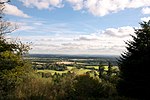Dunsfold Aerodrome
Aircraft assembly plants in EnglandAirports in South East EnglandBuildings and structures in SurreyHawker SiddeleyRoyal Canadian Air Force stations ... and 2 more
Use British English from May 2013World War II airfields in the United Kingdom

Dunsfold Aerodrome (former ICAO code EGTD) is an unlicensed airfield in Surrey, England, near the village of Cranleigh. It extends across land in the villages of Dunsfold and Alfold. It was built by the Canadian Army and civilian contractors as a Class A bomber airfield for Army Co-operation Command. It was commanded by the Royal Canadian Air Force from 1942 to 1944 and was known as Royal Canadian Air Force Station Dunsfold. Under RAF control it was RAF Dunsfold. Post-war it was used by Hawker Siddeley and then its successor British Aerospace. From 2002 to 2020, it was used as the main site of the BBC show Top Gear.
Excerpt from the Wikipedia article Dunsfold Aerodrome (License: CC BY-SA 3.0, Authors, Images).Dunsfold Aerodrome
Simmonds Bridge, Waverley Alfold
Geographical coordinates (GPS) Address External links Nearby Places Show on map
Geographical coordinates (GPS)
| Latitude | Longitude |
|---|---|
| N 51.115 ° | E -0.5325 ° |
Address
Dunsfold Aerodrome (Top Gear Test Track)
Simmonds Bridge
GU6 8HY Waverley, Alfold
England, United Kingdom
Open on Google Maps









